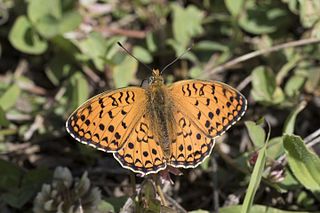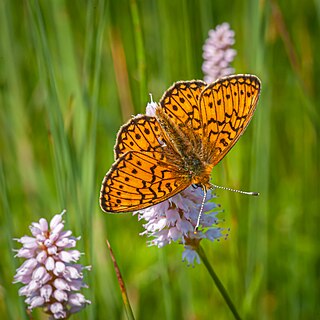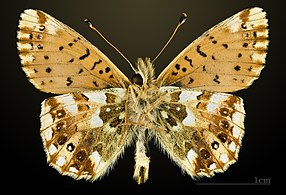
The silver-washed fritillary is a common and variable butterfly found over much of the Palearctic realm – Algeria, Europe and across the Palearctic to Japan.

Boloria selene, known in Europe as the small pearl-bordered fritillary and in North America as the silver-bordered fritillary, is a species of butterfly of the family Nymphalidae. It is found across Europe, Asia and North America, and feeds exclusively on violets in its larval stages. This species prefers wet grassland habitats, where its larval food source, violets, are found. It overwinters in its larval stage, and eggs hatch in the late summer to early autumn. Members of this species are prey for multiple types of birds and other insects.

The pearl-bordered fritillary is a butterfly of the family Nymphalidae found in Europe and through Russia across the Palearctic to the north of Kazakhstan.

The Niobe fritillary is a species of butterfly in the family Nymphalidae.

Boloria is a brush-footed butterfly (Nymphalidae) genus. Clossiana is usually included with it nowadays, though some authors still consider it distinct and it seems to warrant recognition as a subgenus at least.

Boloria aquilonaris, the cranberry fritillary, is a butterfly of the family Nymphalidae. It is found in northern and central Europe.

Boloria dia, the Weaver's fritillary or violet fritillary, is a butterfly in the family Nymphalidae. The name Weaver's fritillary is in honor of Richard Weaver, an English insect collector who claimed to have obtained the specimen within ten miles of Birmingham around 1820. However, B. dia is very rare in England and the few specimens known from there are thought to be from possibly accidental introductions.

Boloria eunomia, the bog fritillary or ocellate bog fritillary is a butterfly of the family Nymphalidae.

Boloria titania, the Titania's fritillary or purple bog fritillary, is a butterfly of the subfamily Heliconiinae of the family Nymphalidae.

Brenthis daphne, the marbled fritillary, is a butterfly of the family Nymphalidae.

Polyommatus daphnis, the Meleager's blue, is a butterfly of the family Lycaenidae.

Boloria bellona, the meadow fritillary, is a North American butterfly in the brushfoot family, Nymphalidae. The common name, meadow fritillary, is also used for a European butterfly species, Melitaea parthenoides.

Boloria napaea, the Napaea fritillary or mountain fritillary, is a butterfly of the family Nymphalidae.

Boloria pales, the shepherd's fritillary, is a butterfly of the family Nymphalidae. It is found from the Cantabrian Mountains and the Pyrenees through the Alps and Apennine Mountains east to the Balkan, Carpathian Mountains, the Caucasus and central Asia up to western China.

Arethusana is a butterfly genus from the subfamily Satyrinae of the brush-footed butterfly family (Nymphalidae). It is composed of only one species, Arethusana arethusa, the false grayling.


















